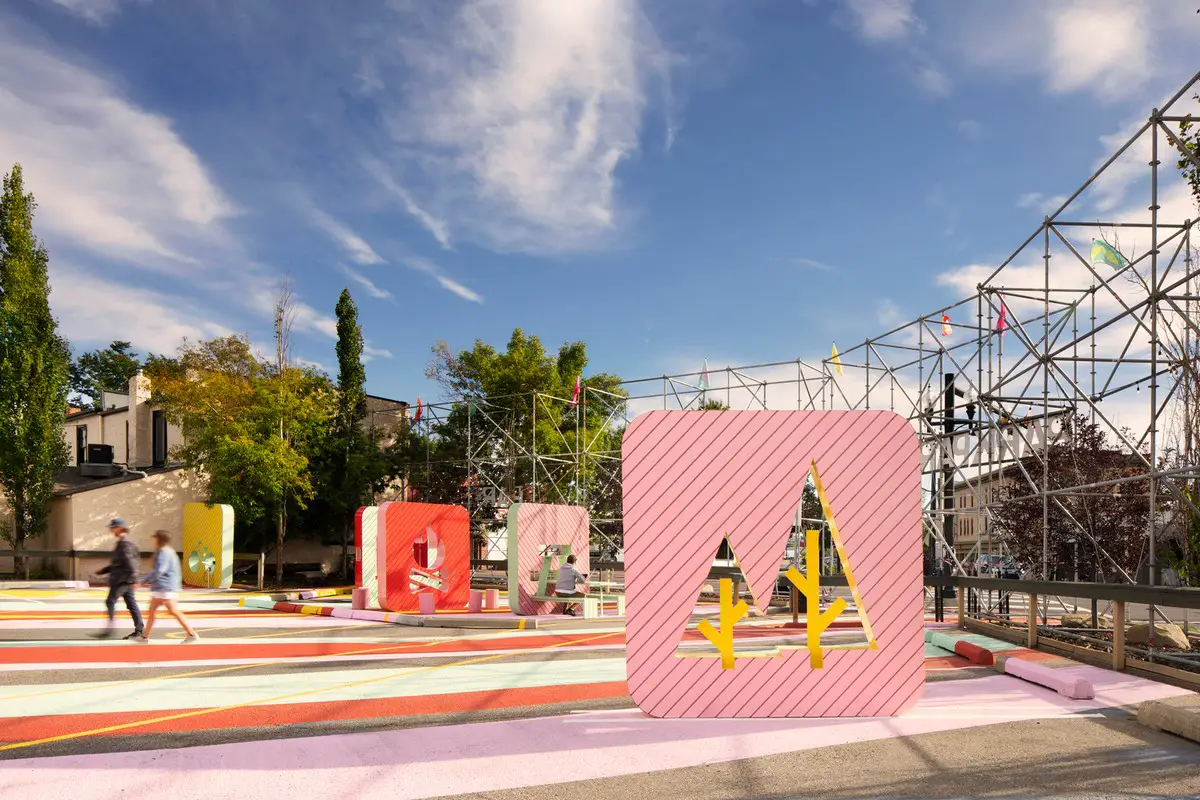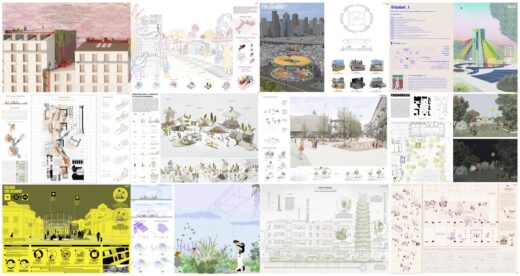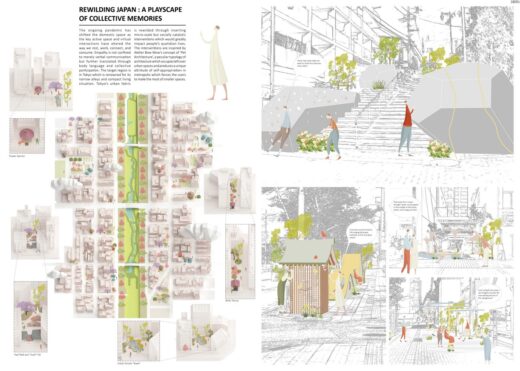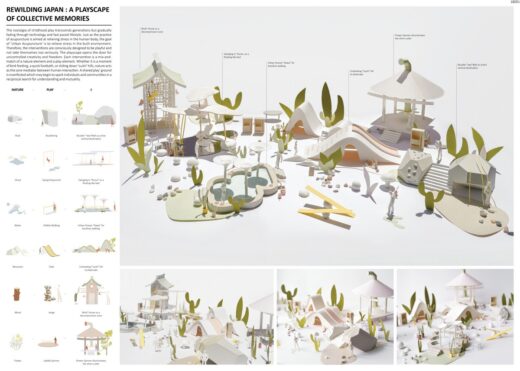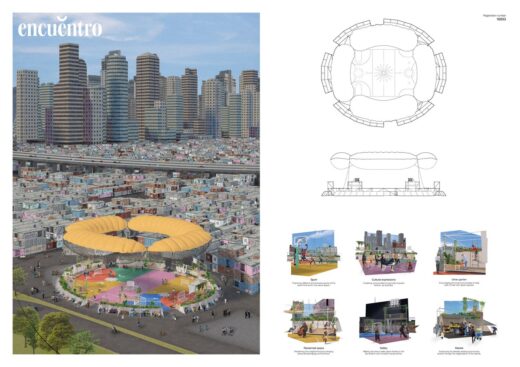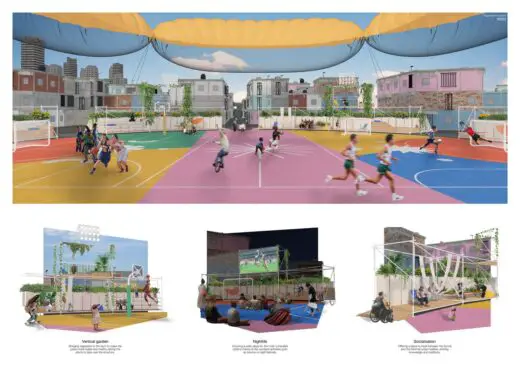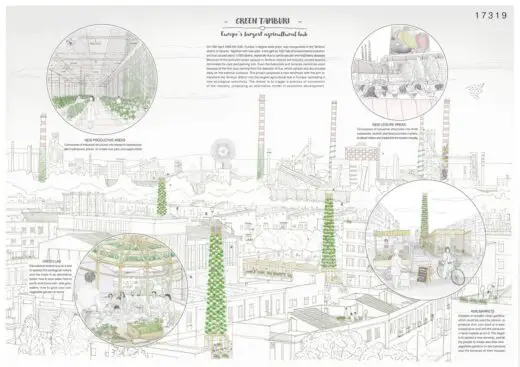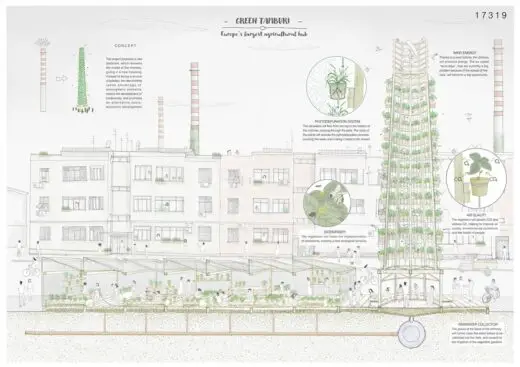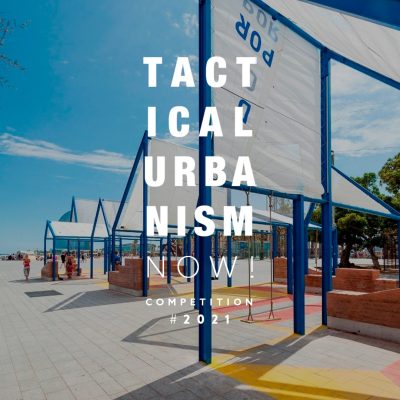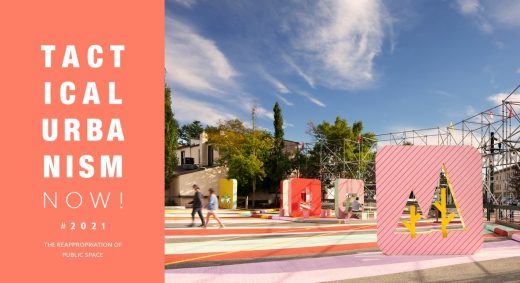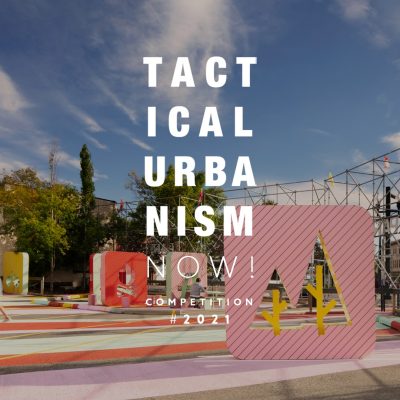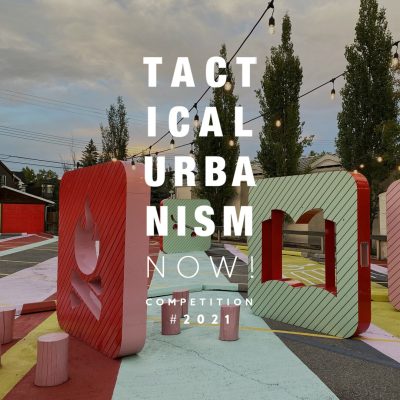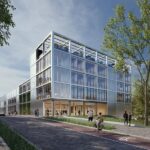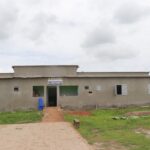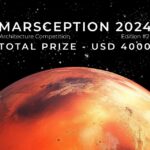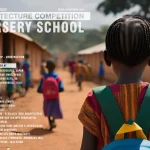2021 Tactical Urbanism Now Design Competition, Public space architecture contest, Transformation
Tactical Urbanism Now Competition 2021 News
post updated 30 April 2022
TerraViva Competitions Announces the Results of Tactical Urbanism Now! 2021
TerraViva Competitions has officially released the complete list of awarded projects of the design contest “Tactical Urbanism Now! #2021”.
Tactical Urbanism Now Competition 2021 Winners
The challenge of this competition was to reinterpret what is commonly known as traditional public spaces, such as parks, streets, playgrounds and squares, with a strategical vision capable of providing them with new features of multi-functionality and flexibility.
The awarded proposals were able to experiment with new scenarios within the city, understanding public space as an opportunity to design common areas capable of reflecting the diversity of the infinite categories of potential users and encouraging citizens to “Live Together”.
TerraViva thanks all the competitors for participating in the second edition of Tactical Urbanism Now!
Organized by TerraViva, the competition was open to students, architects, designers, artists, makers, activists and anyone interested in the transformation of the contemporary urban space.
The winners were selected by an international jury panel composed by:
– Arturo Mc Clean (Barcelona | Miralles Tagliabue EMBT)
– Liz Wreford (Winnipeg | Public City)
– Francesco Garofalo (Rotterdam | Openfabric)
– Nasrin Mohiti Asli (Rome | Orizzontale)
– Hannah Klug (Lima | Intuy Lab)
– Greg Corso (New York | Sports)
– Nathalie Eldan (Paris | Atelier Nea)
– Sojung Lee (Seoul | OBBA)
1st Prize
Project by: Wai Yin Ryan Tung, Ho Yin Cheung, Ching Tao Albert Leung, Long Kwan
Hong Kong
“Rewilding Japan: a Playscape of Collective Memories”
The ongoing pandemic has shifted the domestic space as the key active space and virtual interactions have altered the way we rest, work, connect, and consume. Empathy is not confined to merely verbal communication but further translated through body language and collective participation. The nostalgia of childhood play transcends generations but gradually fading through technology and fast paced lifestyle.
The target region is in Tokyo which is renowned for its narrow alleys and compact living situation. The urban Tokyo’s fabric is rewilded through inserting small-scale but socially catalytic interventions which would greatly impact people’s quotidian lives. The interventions are inspired by Atelier Bow-Wow’s concept of ‘Pet Architecture’, a peculiar typology of architecture which occupies left over urban spaces and produces a unique attribute of self-appropriation in metropolis which forces the users to make the most of smaller spaces.
Just as the practice of acupuncture is aimed at relieving stress in the human body, the goal of ‘Urban Acupuncture’ is to relieve stress in the built environment. Therefore, the interventions are consciously designed to be playful and not take themselves too seriously. The playscape opens the door for uncontrolled creativity and freedom. Each intervention is a mix-and-match of a nature element and a play element. Whether it is a moment of bird-feeding, a quick footbath, or sliding down ‘sushi’ hills, nature acts as the core mediator between human interaction. A shared play’ ground is manifested which may begin to spark individuals and communities in a reciprocal search for understanding and mutuality.
2nd Prize
Project by: Alibek Atahanov, Camila Saulino, Erika Cavallo, Davide Di Bella
Italy
“Encuentro”
Encuentro takes place at the entrance of Barrio Padre Carlos Mugica (also known as Villa 31), the most iconic informal neighbourhood of Buenos Aires, because of its location in the heart of the city, which showcases a huge social inequality. The spot is set just between two realities, represented by business skyscrapers on one side and informal and self-constructed, overlapped houses on the other.
The project aims to generate a space where people with different backgrounds can share a public square, create and strengthen communities through sport and other activities that can take place in a new, bright, green and safe environment.
Encuentro, which combines the term “match” as intended for sports, with the word “meeting” for sociality, represents a tactical popular stadium, a rounded space made of metal scaffoldings and wooden surfaces that create a grid open to free interpretation and personalisation, as the whole neighbourhood is build. In this perspective, people can build their own space by bringing some personal furniture and other elements to share with the community. A social urban garden is also included in the stadium, as the whole neighbourhood lives in a total lack of green spaces or any vegetation. On the exterior, street market cabins are included for the daily fair that currently takes place in the square. The bright giant balloons above the structure act, both symbolically and functionally, as a stadium roof, floating over the place and making it more visible from the surroundings.
3rd Prize
Project by: Giacomo Caputo, Leonarda Pace
Germany
“Green Tamburi”
On 10th April 1969 the ILVA, Europe´s largest steel plant, was inaugurated in the Tamburi district of Taranto. Together with new jobs, it brought a high rate of environmental pollution, and has caused about 11000 deaths, especially due to cardiovascular and respiratory diseases. The dramatic choice between health and work has created social conflicts and rifts in the population.
Because of the pollution pubic spaces in Tamburi district are actually unused spaces, dominated by cars and parking lots. Even the balconies and terraces cannot be used because of the fine dust coming from the deposits of Ilva, which spread and accumulate daily on the external surfaces. The chimneys became the symbol of a neighbourhood that once, due to its geographical conformation and the health of its air, was considered the garden of Taranto.
The project proposes a new landmark, which reinvents the model of the chimney, giving it a new meaning. Instead of being a source of pollution, the new chimney takes advantage of atmospheric elements, (purifying the rainwater and producing energy from the wind) , fosters the development of biodiversity, and promotes an alternative socio-economic development. The goal is to transform the Tamburi district into the largest agricultural hub in Europe, spreading a new ecological sensitivity. The dream is to trigger a process of conversion of the industry, transforming its facilities in research centres, Km0 restaurants, leisure areas, touristic and food promotion centres, proposing an alternative model of economic development.
Golden Mention #1
Project by: Sahar Naz Taleb Nezhad, Tatiana Nebiolo
Iran, Italy
“En Moto – Social Public Transport”
EnMoto SPT: Social Public Transport is an attempt to bring multiple new opportunities to places located along the railway line, once connected Puerto Berrio and Medellin, Colombia. People in this area, don’t have the access to public transport and the city is almost isolated. This project wants to propose a new connection that brings local communities closer to Urban life, offers services which are hardly available in these areas, thanks to an informal means of transport used today in the area the: Motomesa.
This leads the citizens in the city of Puerto Berrio, to come up with the idea of Motomesa which is actually a new way of public transport. This system gets its power from motorcycles, bikes and it can also be used manually. The challenge here is that even though people can have access to other cities nearby, they cannot take advantage of the most public facilities such as healthcare, entertainment, and education.
EnMoto is proposing to use Motomesa as not only a means of transport but also a movable multi-functional building. Where people can use these facilities. An EnMoto system works weekly with different daily programs so that it can cover all the social plans possible during the week. EnMoto is based on this vehicle since it is very easy to be made and whatever piece that might not work well, can be replaced by people without any specific skill. Light structure and flexible box are applied to EnMoto for different uses
Golden Mention #2
Project by: Mariana Paisana, Margarida Marques, Inés Sebastian, Bruno Guimarães, Carolina Barreiros, Moisés Rosa, Carolina Cardoso
Portugal
“Filling the Blanks”
Where? Barreiro Velho, of traditional morphology, abandoned and in process of gentrification, is decimated by a large number of urban voids that appear as an opportunity to extend and increase the limited domestic conditions of the buildings and create new meeting and community places.
What? Tactical urbanism can temporarily activate and provide basic social infrastructures in a territory, as well as initiate and trigger its requalification. Through the deployment of circular infrastructures in vacant plots in Barreiro Velho ( (Metropolitan Area of Lisbon), this proposal aims to create a pilot project to activate the public space and improve the living conditions of the neighbourhood.
How? Through three different scales and typologies of public infrastructure inspired by Portuguese culture (S, M, L, quiosque, coreto, amphitheatre) it is possible to intervene in the existing urban voids, incorporating new services in a degraded urban context, waiting for complete urban regeneration.
The circular shape becomes the basic geometry. The circle, in addition to avoiding hierarchies and generating continuous spaces, creates a disruption in contrast to the straight edges and nooks and crannies of the vacant lots. This contrast allows the perception of the circular infrastructures as a new element, temporary and in transition until effective measures are developed by the public administration. This strategy is replicable and scalable to other similar urban contexts present in different cities throughout the world. Moreover, the flexibility of the system allows the absorption of varied programs according to the social and urban context
Golden Mention #3
Project by: Valentina Del Motto, Maria Mastella, Arianna Zambelli, Ambra Chiesa
Italy
“3 Theaters”
The center of the city of Varese is characterized by the presence of 3 theaters which have always been considered points of reference. The project involves the networking of the open spaces corresponding to each Theater, thus creating a lively and liveable neighbourhood, with a particular inclination towards the arts.
The path is defined by a “carpet”, distinguished by a pavement that acts as a unifying element. The path leads to “islands” of different colour that highlight the urban space in an innovative way and go through streets, squares and specific points of the city, connecting them and making sure that pedestrians see differently the areas they frequent daily. Spatial continuity is also managed thanks to the inclusion of trees, flower boxes and furnishings that use a circular element, modulating it at different scales and sizes according to different functions. Each “island” is defined by the vocation of the place but also by the space that is created thanks to the new interventions and related functions connected to it: play, art, music, performance, street food, conviviality.
The functions are distributed along the paths, the arcades and on the squares: Cinema Impero Square, Varese Theater Square and Politeama Theater Square, places designed to be flexible and accommodate different activities. The project is dominated by a strong element of social, generational and physical inclusiveness and by a profound predisposition to the increase of natural elements in the city, which bring great benefits to people and contribute to the increase of biodiversity.
Golden Mention #4
Project by: Jorge Andres Darcourt, Sergio Puch
Peru
“Oasis in the Urban Desert”
Lima is a city that has been built in the desert, thanks to the ancient cultures who developed a fertile valley. However, in the present, the continuous and unplanned growth of the city has erased big part of the green areas and natural ecosystems, leading to a huge problem that is commonly left aside. This situation led the poorest districts of Lima to have enormous and worrying issues with the water and vegetation, linked generally to a lack of public spaces of quality.
One of these districts is Villa el Salvador, that has been founded by a government initiative, but has been developed by the half million people that were living there from the beginning. This self-managed district has an urban morphology of a perfect grid, where the public spaces were designed, but now these spaces look empty and neglected. Because of these poor conditions the people have developed a practice that brings life to their streets. They built their own domestic gardens with diverse flora in front of their houses, taking care and watering it by their selves. These green spaces are oasis in the desert.
The project seeks to learn from this practice and give the district a device that can repair and regenerate natural spaces creating biodiversity. The mobile device has a water tank at the top with a steel structure which facilitates the watering of areas and offer a solar protection. The second device in scale, works as an urban equipment open for multiple uses.
Honorable Mention #1
Project by: Amy Evans
Australia
“Urban Platforms”
This project aims to enrich the community of Brunswick, Melbourne by utilising disused sites and former industrial areas as temporary Urban Platforms for exhibiting art. Through an adaptable set of modular elements, the project will migrate from site to site, transforming each host site into a temporary public space and cultural forum. Brunswick once attracted artists from around Australia for its affordable rent. With rapid densification and gentrification, affordability has declined – jeopardising the rich artistic community that is central to Brunswick’s identity.
Urban Platforms simultaneously addresses two problems; the lack of accessible and affordable spaces to exhibit art, and the plethora of vacant industrial sites left behind by socio-economic fluctuations. The project proposes to transform such sites into temporary public spaces. As property developers move in, Urban Platforms will migrate, packing up and adapting to the next host site.
The initial host site for Urban Platforms is the former Brunswick Liquorice Factory site. Located adjacent to Brunswick Station, this site acts as a gateway to Brunswick, guiding pedestrians through a linear outdoor gallery and public space. The project consists of a series of modular elements; platforms, ramps, lights, seats, walls, and plinths. The platforms become the new ground, allowing the existing ecology to thrive; they can be levelled to suit any terrain; and ramps provide accessibility. Remaining elements slot into the platforms and can be reconfigured to suit each event. Ultimately, the project aims to become a catalyst, to utilise these sites for cultural outcomes rather than solely economic investments.
Honorable Mention #2
Project by: Chenhao Luo
China
“New Forms of Co-Urbanity”
The project intends to challenge the basic assumptions behind this type of urbanism that presents the city as a functional and productive apparatus and as an object of consumption and that promises happiness and wealth but delivers control and alienation. The project understands the city as a fundamental political act, a contested territory with multiple actors, identities, and values.
A space of negotiation where conflict is accepted and understood as the basis of the urban social contract. It recognizes the need for public space not simply as entertainment or palliative but as a space of appearance where individual recognize each other into a social body instead of been dissolved in the fragmentation of multiple individualities. The project interested in the idea of the politics of presence, where the basis of the political world is the recognition of others, that is the possibility to appear in front or others. propose to start from a small series of enquires and explorations about the possible collectives that may lay latent in the city.
The project assumes there are multiple and complex and yet unexplored forms of exchange and negotiation that can inform new possibilities for the city and its architecture. The aim of the project is not to find a solution to the challenges of the area and its inhabitants, but skeptical on what someone else called the “problem with solutions”; therefore, the project will instead use the area as a laboratory of” possible collective imaginaries”.
Honorable Mention #3
Project by: Kongho Wong
United Kingdom
“Co-Encrypting Murmur”
This is not a design project, this is manifesting a movement. Hong Kong has moved to the next phase away from massive demonstrations battled with armed police in 2019. While people reflect and heal, the general public valued their right to the city more than ever before. Therefore there is a collective call on a new paradigm of urban space for this situation.
Common Practice: ‘Mur Mur’. Murmur is usually described as complaining about something you disagree with in a private setting. It is an intimate social behaviour where we feel free to share our feeling. In Hong Kong, ‘murmur’ could be considered as a quintessential spatial practice, to share the frustration, furry, dissatisfaction, fear, sorrow or happiness with one another.
As we introduced a gamified urban tactic called ‘Co-encrypting Mur Mur’, this transformed into a guerilla within city. The Murmur machine is relatively analogue, sometimes a bit old school prototype. However, it also embraces a straightforward approach to empower people to create and reimagine our everyday spaces with the most approachable recycled wastes. A leaflet-liked manual will be distributed in the city. This aims to create an ambient urban network in which the murmur echos surround streets and spaces between buildings. The soundwaves then will be encrypted in the form of NFTs, circulating in the virtual world which will last longer than the tyranny. We will wait for the day that history is allowed to be revealed.
Honorable Mention #4
Project by: Margaux Bitton
France
“The Upper Space”
Without a doubt we have gone through an unprecedented crisis, where space becomes a primary issue, with a new approach to our dense cities, emphasizing the urge of exploring new spaces in urban areas. To do so, we identify and give access to a real gem that has yet to be explored in depth : roofs. The goal is to spread the public space to this upper dimension, flexible and adaptable in several steps to each situation.
The first layer is a duckboard in steel, fixed above roofs to preserve them, outlining high perched walks. These walkways are connected to the street thanks to caged ladders or elevators, giving access to all. The horizontal duckboard turns into a wire fence going along gables and hanging to cheminies. Its porosity allows the runoff of rainwater. Its red colour is a landmark and a nice touch.
The second layer is for activities, thought as modules to plug to the first layer. Reading, playing chess or basketball, sunbathing, having lunch, climbing… as many things as the city must offer, mainly to provide the entire community with new functional areas generating life and interactions, encouraging citizens to “live together”. The third layer is vegetation, climbing on the wire to preserve the building, integrated in the duckboards converted into planters to host urban vegetable gardens. The collective imagination can finally flourish all over the roofs of the world. A take-off for the urban space.
Honorable Mention #5
Project by: Florence Methot, Brittany Gray, Samantha Richman, Christian Coronel, Liza Otto, David Ruiz, Pedro Cruz, Gregory Melitonov
Mexico
“Teatro Estacion Cultural Tapachula”
There is a migration crisis at the Southern border of Mexico. Since 2012, a larger number of unaccompanied minors and families from the Northern Triangle are fleeing unprecedented levels of violence and persecution. Given the inability of the system to respond to the new reality in a humane and efficient way in the light of the government’s legal obligations, this project proposes to use tactical strategies to alleviate migrants’ situation while waiting for regularization.
Teatro Estacion Cultural is a non-profit initiative by a group of architecture students who are building an open-air theater for a cultural center in Tapachula, Mexico. It is intended to be a new public arena, designed to function as a cultural bridge between the poor local community and transient migrant families. The project was first developed when we traveled to Tapachula to study the humanitarian crises currently taking place and met with many migrants who had experienced sexual assault, kidnapping, disappearances, and the death of their loved ones along the way. These stories impelled us to do more.
This project is based on a partnership with a design-build program founded by the firm Taller Ken, as well as a small community of locals who had taken over an abandoned train station and turned it into a makeshift community space. This is a space where locals and migrants alike find an outlet for cultural expression and freedom through theater, dance, and arts education. It is called La Estación Cultural.
Honorable Mention #6
Project by: Chiara Milella, Diletta Ciuffi
Italy
“@babel_t”
@babel_t is a way of thinking about public space aimed at enriching the inhabitants by sharing spaces, events and creative visions. Piazza Selinunte is the neighbourhood in Milan with the highest number of residents from foreign countries, so we thought of a project that would borrow the name of the famous “Tower of Babel”, distorting some of its features. Starting from the existing tower, which stood as a negative landmark, the symbol of an unpleasant neighbourhood, we designed a frame that would wrap around the existing structure.
Thanks to its appearance, the new tower succeeds in becoming an explicit synthesis of a place that welcomes diversity, promotes communication, respects cultures and increases the ability of citizens to interact with each other, despite the apparent language barriers. How to do this? Through an infrastructure that promotes art in all its forms. @babel-t hosts a space for city events and exhibitions on the ground floor and connects to the surrounding city through different frames that have the task of reconnecting the area of the working-class neighbourhood with the nearby San Siro, known for its stadium and luxury housing.
The frames that radiate out from the tower create different types of spaces aimed at different categories of people, including children with play areas, adults with places to relax, spaces for the municipal market and art spaces, and young people with meeting spaces and new opportunities for sport.
Honorable Mention #7
Project by: Nomundar Munkhbaatar, Battushig Togtokh, Glynis Hong
Mongolia, Singapore
“Collection Point”
Problem – Due to unregulated land grants and rampant real estate development for the past 30 years, the residents of Ulaanbaatar experience a severe shortage of public spaces. This problem is exacerbated in the ger areas, a settlement area comprising gers (traditional Mongolian tents) and detached housing, where 60% of all Ulaanbaatar residents live. In the absence of basic infrastructure and public spaces, ger area residents do not have the opportunity to feel part of a community.
Target – Thus the need of creating public spaces within the ger areas becomes a priority given the underserved nature. By creating a public space to gather, connect and build strong ties to each other and to place, we will enable pathways to a close-knit and safe community.
Concept – Within the ger areas, one of the most trafficked places is a water kiosk which draws one member of each household regularly. It is a water collection point, where household members visit to fetch water for domestic use. Even though it is visited by many, there is no function that enables interaction between residents.
Our design is inspired by the ger and its central fireplace as a traditional place of gathering. Our proposed structure consists of a firm base, circular seating arrangement and a light weight canopy adjacent to the water kiosk. Building upon this traffic point, we are aiming to transform water kiosks into an intentional public community-building space where ger area residents can: collect, converse, connect, celebrate.
Honorable Mention #8
Project by: Jacob Chawner, Joseph Riordan, Sam Hall, Magdi Khalil
United Kingdom
“City Hall Square”
Budapest was selected as the location for this intervention for multiple reasons. The expansive and unique thermal bath network and the disparity between the municipal and national governments became the key drivers of this decision.
The political tensions between the local and national authorities presents a link to classicism and its power hierarchies. Key aspects of Classical architecture such as top-down design and presentation of power was explored through intercolumnation and scale, and the idea of reclaiming these classical features as part of a bottom-up community intervention.
The light-touch intervention introduces mixed use public spaces to the square and develops the courtyards in the city hall as extensions of these public spaces. Each space presents a unique experience, drawing on local community needs, native flora, and the unique thermal bath culture. The ground floor of the city hall has been redistributed to local commercial enterprises, with the aim of redefining the municipality building as a bottom-up initiative.
The scheme considers the local community at the scale of the individual, promoting pedestrian access and introducing the style and geometry of classicism at a human scale. The deliberate misuse of classicism through colonnades highlights the community/municipality conflict and elevates the ordinary people of Budapest to the level of the authorities.
Honorable Mention #9
Project by: Yu Han Ching
Singapore
“Garden of Everyday Relations at Chai Chee”
The project explores the relationship between public art and community engagement, and the emergence of a new space for artmaking that is antithetical to a museum’s design, use, and meaning. Stemming from the relational principles of relational aesthetics, the project positions everyday things (personal possessions, public furniture, infrastructure, etc.), spaces and activities as active, relational agents. They provide opportunities for public art to emerge, recontextualising the institutional and conventional settings of art making, presentation and viewing (studios, galleries and museums) by embedding them amidst the Chai Chee community in Singapore.
Due to the substantial number of government rental flats in Chai Chee, one can find a community largely made up of low-income earners and elderly retirees in this area. The project posits itself against the backdrop of increased social isolation among elderly in Singapore and imagines a series of bottom-up interventions situated at the everyday spaces and objects of this community such as void decks, parks, sheltered walkways and public furniture. These interventions invite social curation and inhabitation of the community’s personal possessions, fostering communal activities and practices.
The project believes that through the engagement with the community, the values, meanings, relations of these spaces and objects will change over time. They provide opportunities for conversations, storytelling to happen and the possibility of a new architectural typology for socially-engaged art in the twenty-first century.
Honorable Mention #10
Project by: Lucia Emma Avolio, Matteo Andreoletti
Italy
“Paranomasia”
PARANOMASIA stems among a constellation of buildings, collocating itself in a void in the city frame-work. An example of its funcionality is the urban reactivation of a garden in Milan, located alongside works by Gio Ponti, Vittoriano Viganò, Renzo Piano, behind the Guido Romano swimming pool. In the great po-tential of this area, PARANOMASIA expresses its meaning: five urban objects redesign, reactivate and re-claim a neighborhood space, adapting themselves to the needs of living and introducing a contemplative dimension.
In these days marked by the reduction of social ties and community experiences, they aim to generate op-portunities for dialogue among the various generations, to promote a renewed sense of belonging to places through flexible spaces and small pavilions dedicated to those who live the neighborhood. A THEATRE, as a relational space dedicated to children and their plays and parties, a LIBRARY for young people to study peacefully enjoying some silence and relax in the greenery of the JUNGLE, or contemplate the sky from the OBSERVATORY, the landmark of the project. A multifunctional meeting place is the KIOSK: bar and disco.
PARANOMASIA represents an invitation to be involved in the non-visible places of the urban landscape to multiply the opportunities for collective experiences. The aim is to reveal the “sense of place”, actively liv-ing the space and to transfer a feeling of embrace, of curiosity and sharing through a light intervention that delivers new quality and new ways to offer the space back to the city.
Previously on e-architect:
8 December 2021
Tactical Urbanism Now! 2021 Competition
TerraViva Competitions launches TACTICAL URBANISM NOW! 2021, a new edition of the architecture competition that puts the focus on the transformation of public space all over the world. Prizes up to 7.000 € will be awarded to the winners selected by an international jury panel composed by, among others, Arturo Mc Clean (Miralles Tagliabue EMBT), Liz Wreford (Public City), Francesco Garofalo (Openfabric), Hannah Klug (Intuy Lab);
PublicCity:
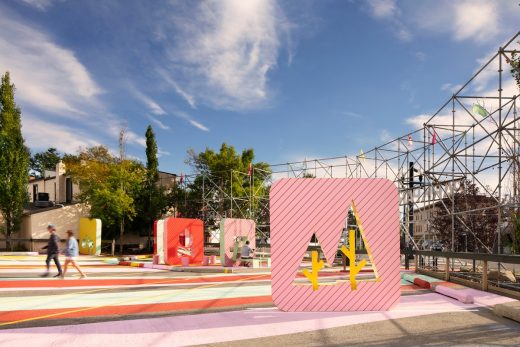
photo © Kokemor Studio
Tactical Urbanism Now Competition 2021 – Design Contest
Brief
Over the last decade, cities all around the world have experimented with a wide range of urban transformations through colourful, flexible and light interventions. Nowadays, it has become more and more common to come across these type of projects in both, small towns and metropolises.
Tactical Urbanism proposes an innovative design approach that aims to achieve long-term regeneration with short-term strategies. In certain cases, due to the positive impact that these interventions have generated in the urban realm, projects that were once thought of as temporary have now become permanent.
Working at the scale of a street, a block or a building, tactical tools have the power to improve liveability citywide. Similar to the way acupuncture inserts needles into one part of the body to boost the well-being of the entire organism, these type of projects can actually lead to positive changes in an entire neighbourhood.
Prizes & Mentions
- 1st Prize: 3.000€
- 2nd Prize: 2.000€
- 3rd Prize: 1.000€
- 4 Golden Mentions: 250€ each
- 10 Honourable Mentions
- 30 Finalists
Guidelines
The challenge of this competition is to reinterpret what is commonly known as traditional public spaces, such as parks, streets, playgrounds and squares, with a strategical vision capable of providing them with new features of multifunctionality and flexibility.
Tactical design can be considered as an instrument for carrying out experimental projects of high communicative value, aimed at improving public spaces or even creating new ones from scratch. Today, the challenge is to design inclusive and accessible spaces, capable of reflecting the diversity of the infinite categories of potential users and encouraging citizens to “Live Together”.
Participants are therefore invited to explore and experiment with innovative strategies, original ideas and unconventional concepts. The key point is to be able to think out of the box in order to imagine lively and attractive urban scenarios which guarantee permanence, interaction and variety of uses.
Scalability and modularity can be fundamental aspects to be taken into consideration when developing the concept. How many different of activities can be carried out in the same place? How could an urban void be radically transformed in order to foster social interaction?
Be creative and explore all the possibilities to imagine a new kind of public space!
Requested Material
Competitors have to submit two A1 panels (59,4 x 84,1 cm) landscape oriented + a brief text describing the proposal (up to 250 words). Panels must contain all the necessary graphic information to explain the project in the best way possible (title, diagrams, sketches, 3D visualizations, plans and sections, collages, model photos, etc.). All kinds of graphic representations will be accepted.
Jury
- Arturo Mc Clean | Miralles Tagliabue EMBT (Barcelona, Spain)
- Liz Wreford | Public City (Winnipeg, Canada)
- Francesco Garofalo | Openfabric (Rotterdam, Netherlands)
- Nasrin Mohiti Asli | Orizzontale (Rome, Italy)
- Hannah Klug | Intuy Lab (Lima, Peru)
- Greg Corso | Sports (New York, USA)
- Nathalie Eldan | Atelier Nea (Paris, France)
- Sojung Lee | OBBA (Seoul, South Korea)
Schedule
- Competition Opening December 13th 2021
- 59 € “Early” Registration Ends December 28th 2021
- 89 € “Standard” Registration Ends March 4th 2022
- 119 € “Late” Registration Ends March 18th 2022
- Submission Deadline March 18th 2022
- Results Announcement April 26th 2022
Download full brief at www.terravivacompetitions.com/tactical-urbanism-now-competition-2021
Requirements / Eligibility
The competition is open to students, architects, designers, urbanists, engineers, artists, makers, activists and anyone interested in the transformation of the contemporary urban space. Participants can join the competition either individually or with a team.
Instagram: @terravivacompetitions
Facebook: TerraViva Competitions
Twitter: @terravivacompetitions
More information at: www.terravivacompetitions.com
Contact: info@terravivacompetitions.com
Tactical Urbanism Now Competition 2021 images / information received 081221
Previously on e-architect:
TerraViva Competitions
The Cuban Square Architecture Competition, Havana, Cuba
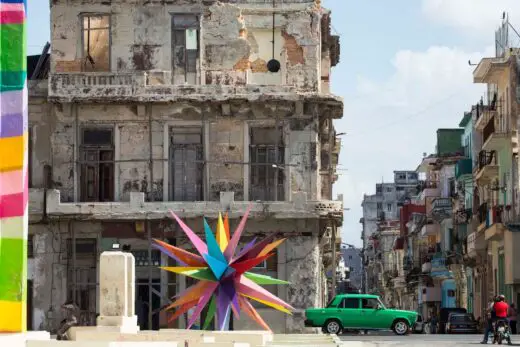
image courtesy of TerraViva Competitions
The Cuban Square Architecture Competition
Hangar Ticinum Competition 2021
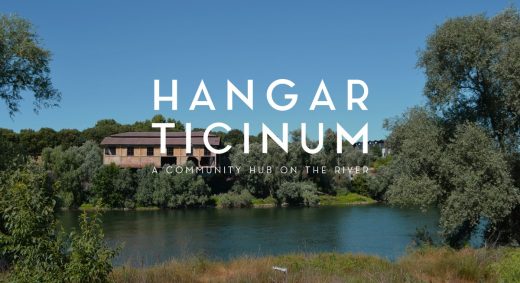
Hangar Ticinum Competition
Architecture Competitions
Architectural Competitions : links
Architecture Competitions – architectural selection below:
Tiny House Competition 2021
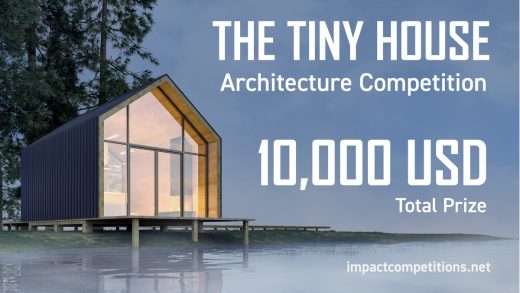
Tiny House Competition 2021
Oxford Innovation District Competition, Begbroke Science Park, Kidlington, England, UK
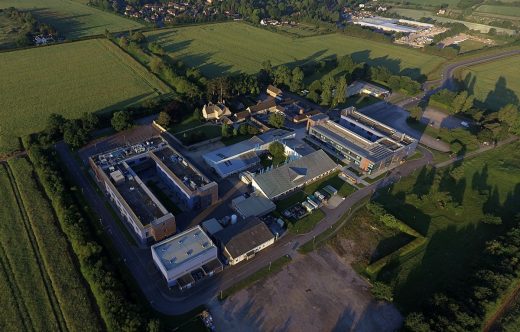
image courtesy of competition organiser
Oxford Innovation District Competition
The Shelter Competition by arch out loud in 2021
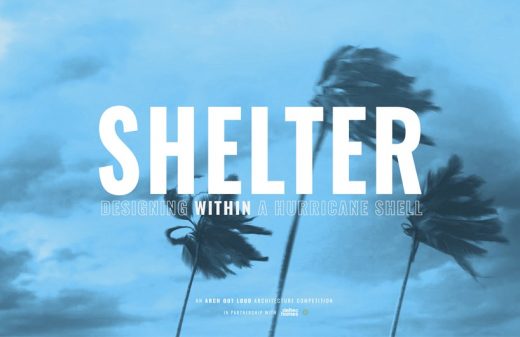
Shelter Architecture Competition
Architectural Designs
Comments / photos for Tactical Urbanism Now Competition 2021 page welcome

